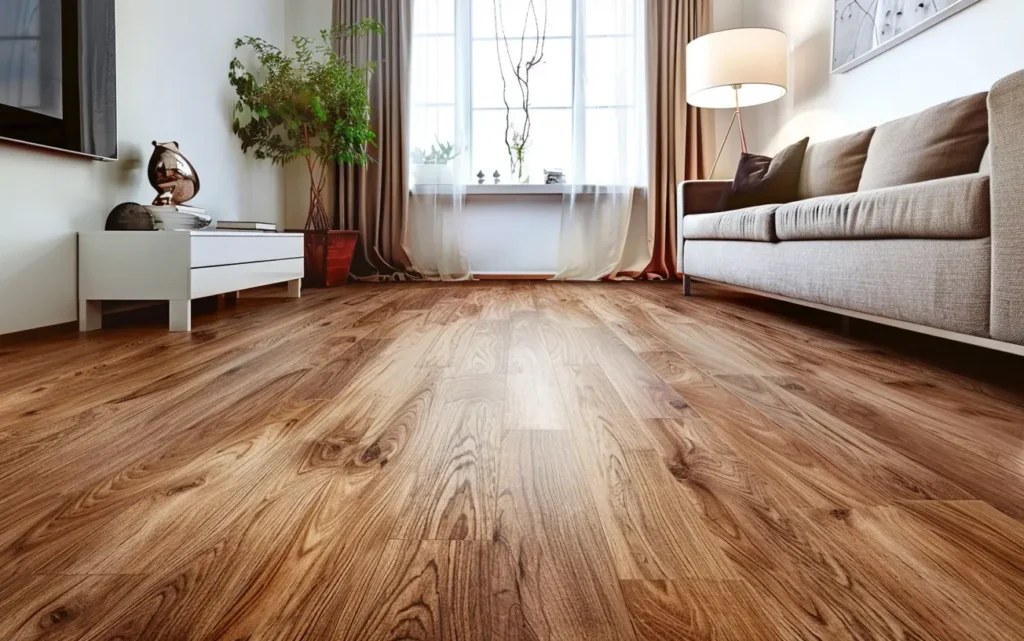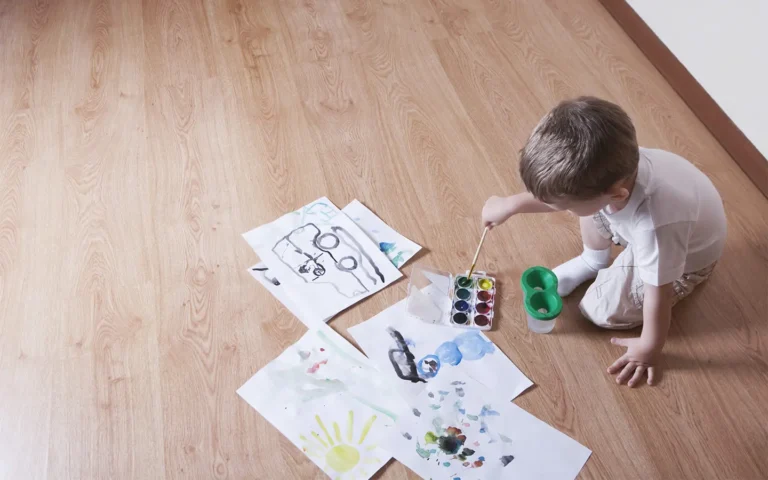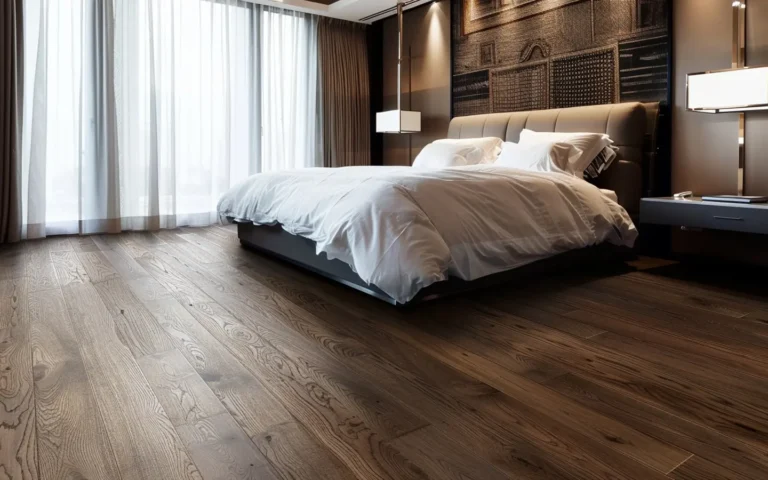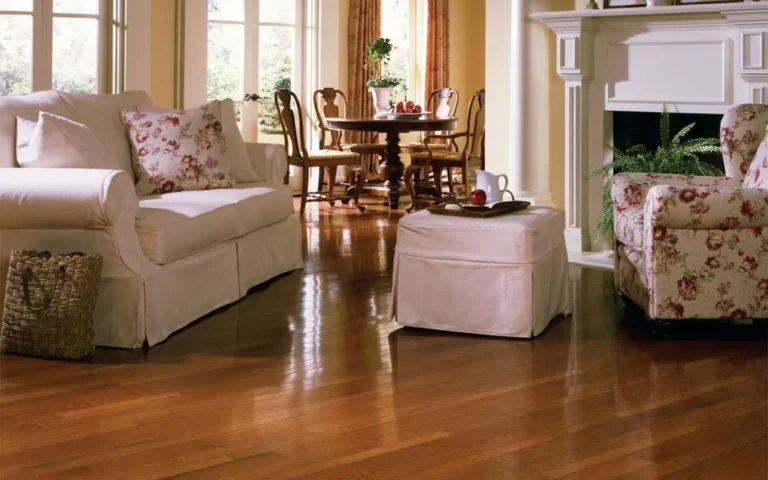Vinyl flooring reigns supreme in both residential and commercial places.
It is affordable, durable, and versatile. However, there are some serious concerns regarding its potential health risks. So who is the culprit?
Volatile organic compounds (VOCs) and phthalates – chemicals commonly found in vinyl flooring. These chemicals can negatively impact indoor air quality and human health if left unchecked.
Is Vinyl Flooring Toxic?
Vinyl itself, also known as polyvinyl chloride (PVC), is a synthetic material.
During its manufacturing process, various chemicals are used to create its desirable qualities like flexibility and water resistance. These chemicals can off-gas – that is, they slowly release VOCs into the surrounding air, especially in the initial period after installation.
This “off-gassing” is not exclusive to vinyl flooring, we also talked about the toxicity of laminate flooring.
Let’s take a closer look at the two main culprits:
VOCs (Volatile Organic Compounds)

VOCs are a group of organic chemicals that easily evaporate at room temperature.
The most common VOCs that can be found in vinyl flooring include benzene, formaldehyde, and toluene.
Exposure to higher VOC levels can irritate the eyes, nose, and throat. It causes headaches and dizziness and can cause respiratory problems. In extreme cases, long-term exposure may even affect the liver, kidneys, and central nervous system.
Children and pets, who spend significant time in close contact with the floor, are at higher risk of exposure to these emissions.
Phthalates
These are plasticizers added to vinyl to make it more flexible and durable. While some phthalates have been banned due to safety concerns, others remain in use.
Phthalates are classified as endocrine disruptors, meaning they can interfere with our hormonal systems. They have been linked to potential health issues, especially in children, such as developmental problems, reproductive issues, and increased allergies and asthma.
Best Brands of 2024
Does Non-Toxic Vinyl Flooring Exist?
The answer isn’t a simple yes or no.
No vinyl is completely free of chemicals. By its very nature, vinyl requires plasticizers and other additives during the manufacturing process. Even the most eco-friendly options will likely have some level of VOC emissions.
Focus on low-VOC vinyl options. The best way to make sure you are safe is by choosing vinyl flooring with minimal VOC emissions.
Look for certifications like FloorScore or GREENGUARD Gold, which indicate the product meets strict VOC emission standards.
Look for labels such as ULEF (ultra-low emitting formaldehyde) or NAUF (no added urea-formaldehyde) to ensure lower emissions and a safer indoor environment.
Choosing Low-VOC Vinyl Flooring

If you want to create a healthy indoor environment, you have to go beyond just the vinyl itself. Here are some of the steps you can take to minimize your exposure to VOCs and phthalates:
- Prioritize low VOC vinyl flooring: Choose brands that are well known for their commitment to sustainability and low emissions. You can even research their manufacturing processes and certifications, most of that information can be found online.
- Avoid cheap vinyl flooring: Don’t be seduced by low prices. Always check if it meets strict criteria for low levels of VOCs.
- Ventilation: During and after installation, maximize ventilation by opening windows and using fans to help VOCs dissipate faster. Consider keeping the area well-ventilated for a good few days after installation.
- Low VOC adhesives matter: Don’t underestimate the impact of adhesives used during installation. Look for low VOC adhesives specifically designed for vinyl flooring.
Consider alternatives
Explore naturally lower VOC flooring options like:
- Solid hardwood: A timeless classic, solid hardwood offers excellent durability and beauty, but can be susceptible to moisture damage and is more expensive than vinyl.
- Cork: This sustainable flooring option has excellent sound and thermal insulation properties, but may require special care and can be more expensive than vinyl.
- Ceramic or porcelain tile: Known as highly durable and resistant to moisture, tile is a perfect choice for kitchens and bathrooms, but can feel cold underfoot.
- Linoleum: Made from natural materials like linseed oil and cork dust, linoleum is naturally anti-bacterial and a good choice for allergy sufferers. However, it requires specific cleaning methods.
The Choice is Yours!

With so much information and conflicting opinions about the “Is vinyl flooring toxic?” question, it’s easy to feel overwhelmed.
Remember, choosing flooring ultimately comes down to your personal priorities and your comfort level. Balancing durability, cost, and health considerations is a process many homeowners face.
Frequently Asked Questions About Non-Toxic Vinyl Flooring
Q: Are all vinyl flooring brands equally toxic?
A: No. Look for reputable brands with a commitment to sustainability and low emissions. Research their manufacturing processes and certifications like FloorScore or GREENGUARD Gold.
Q: Is there a way to tell if vinyl flooring is off-gassing?
A: A strong chemical odor is the most obvious sign of off-gassing. However, some VOCs are odorless. If you’re concerned, consider purchasing a VOC meter to measure air quality levels.
Q: How long does vinyl flooring off-gas?
A: The most significant off-gassing typically occurs right after installation. However, lower levels of VOC emissions may continue for weeks or even months. Good ventilation can significantly speed up this process.
Q: What if I already have vinyl flooring installed? Is there anything I can do?
A: Absolutely! Here are some tips:
- Maximize ventilation: Open windows and use fans to improve air circulation, especially in the initial months.
- Add air-purifying plants: Certain houseplants naturally filter VOCs from the air. Consider adding plants like snake plants, spider plants, or various palms.
- Regular cleaning: Dust and other particles can trap VOCs. Regular vacuuming and mopping will help reduce the amount of trapped VOCs in your living space.
Consider a sealer: Products specifically designed to seal vinyl flooring may reduce VOC emissions over time. Research the options carefully and choose a non-toxic sealer if possible.
About The Author

Steph Gregerson
April 20, 2024
Steph is a book nerd, rule follower, and pizza lover who can't get enough of playing outside. She was raised on the ice rinks of MN and currently resides in sunny San Diego. As a freelance writer, she loves research, producing content, and organizing information for a wide variety of clients. She currently has at least 10 browser windows open at all times.





